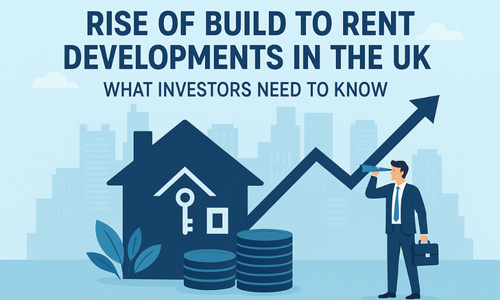Rise of Build to Rent Developments In The UK:What Investors Need To Know

In recent years, with the dynamic and fast-growing segment of the UK Property market, Build To Rent (BTR) developments have emerged.
Typically in urban centres, catering to young professionals, families and lifestyle amenities, BTR projects offers modern, professionally managed homes designed specifically for long term renting rather than for sale. Renters now make up a larger portion of the population, driving demand for high- quality rental housing with housing demand outstripping supply and home ownership becoming increasingly out of reach for many.
There’s a compelling opportunity presented for investors. Major cities like Birmingham, Manchester London are fuelled by government support, strong tenant demand and evolving planning policies. Moving beyond 2025, it is imperative for investors focusing on the resilient and profitable property sector to learn the fundamentals of Build-to-Rent, the market drivers and plausible risks.
What is Build-to-Rent:How It Differs From Traditional Buy-to-Let?
Rather than for individual sale to homeowners, BTR is a residential property development specifically willed and built for long-term rentals.
But the question is how? — Build-to-Rent properties are professionally managed services, consistent quality across the development and communal spaces typically owned by institutional investors (e.g. property companies or pension funds)
Key Differences Between Build-to-Rent and Buy-to-let:
- Build-to-Rent: they are particularly built for renting only, with professional management onsite services. Maintenance is responsive and centralised, and ownership is by companies or institutions, whilst their investment is for long-term, stable income for institutions.
- Buy-to-Let: Individual investment for capital gains or income depending on landlord capacity. They are built to sell, then rented by individuals and owned by private landlords. They are individual units or small portfolios.
This is also explored further in our article on why buy-to-let is a better investment than buying a home.
Why Build-to-Rent Developments Become Popular In The UK Property Market
Due to rising demand for high quality rental housing in the UK especially in major cities, Build-to-Rent developments are now increasingly popularised.
Hence, renting longer due to tighter mortgages, lifestyle flexibility and high house prices, many families are renting longer than expected. The trend is particularly strong among younger demographics, with many millennials choosing to rent due to lifestyle preferences and economic pressures.
Therefore, professionally managed rental homes with onsite amenities such as co-working spaces, 24/7 maintenance and gyms, are now being offered by developers and investors. For renters who need convenience, reliable services, these features are more appealing. Compared to traditional buy-to-let, BTR offers long term growth potential, stable rental income and less risk.
Reasons for Popularity:
- Urban areas with high rental demand.
- Modern amenities in quality homes.
- Tenants attracted by professional management.
- Long term returns that are stable for investors.
- Planning incentives and support from the government.
UK Cities With The Highest Concentration of Build-to-Rent Projects
In key urban centres in the UK, BTR has now become a major investment focus:
-
- London now accounts for approximately 44% of all multifamily BTR stock, and fairly 30% of new build homes in London emerge from BTR development.
- Manchester has more than 19 000 units liberated in the Greater Manchester area in the past decade as a primary regional city in the BTR space.
- Birmingham has over 16 000 Build-to-rent units beneath the planning or construction stage, it is the fastest growing BTR market outside of London.
- Leeds and Wakefield is a forceful developer interest and early project pipelines amidst the top tier regional hotspots. In fact, recent trends show investment property price growth for Leeds — another strong indicator of its regional potential.
- Regional Focus Beyond London- with nearly 60% of new Build-to-rent now outside Manchester and London, some cities such as Glasgow, Liverpool and Coventry are seeing rapid BTR development.
Types of That Typically Rent Build-to-Rent Properties
For tenants who value reliable service, quality amenities and convenience, BTR properties usually attract those tenants who want skilfully managed homes, flexible and modern in well connected urban areas.
Profiles of Tenants in BTR:
- Young Professionals — those who prefer amenities like gyms and co-working spaces but also want to live close to work. It is a large segment of Build-to-Rent tenants.
- Small Families and Couples — tenants who prefer more family friendly characteristics, more secure environments and admire large layouts.
- Corporate Renters and Key Workers — typically prefer managed services near employment centres and flexible lease terms.
-
- In Select Schemes (Students) — Build-to-Rent developments especially near colleges and universities.
- Downsizers and Retirees — value on-site community features and maintenance free living.
Pro tip:: Long-term investments are ideal especially if BTR properties are designed to suit a broader mix of tenants who want security, stability and high quality rental homes.
How Build-to-Rent Investments Impact Rental Yields and Capital Growth
In high demand urban areas, BTR investments are more likely to offer powerful steady capital growth and rental yields. Build-to-Rent often reduces vacancy rates, generates consistent income and attracts reliable tenants because they are professionally managed and tailored to long term renters. This demand is well-supported by recent reports showing that demand for rental accommodation reaches record high.
Impact on Rental Yields:
- Higher Occupancy : Due responsive management and some amenities, Build-to-Rent properties uphold high-occupancy.
- Premium Rents: Some tenants prefer modern living spaces, onsite services and are prepared to pay for more convenience.
- Fewer Voids: Investors often experience minimal income gaps because of strong tenant retention and demand.
Impact on Capital Growth:
- Advantage in Urban Location: Growing cities worth strong infrastructure, long-term property value is what investors prefer for building BTR schemes.
- Demand-Driven Appreciation: Price growth due to rising rental demand in certain areas.
- Professional Maintenance: Ongoing property upkeeps appeal to future institutional buyers and enhance value over time.
How Government Policy Influences The Growth of Build-to-Rent Developments?
The growth of Build-to-Rent (BTR) development in the UK is encouraged by the government policies because it plays a major key role. To support the expansion of BTR as a long-term housing solution, the government has introduced several measures, as demand for quality rental housing rises, especially in urban areas. This aligns with recent tax reforms where property investors stand to benefit from tax relief.
How Government Policy Is Supporting BTR Growth
-
-
- For developers to gain approval for rental-only schemes, the government officially recognised BTR as a diverse housing sector in planning policy.
- For developers to gain approval for rental-only schemes, the government officially recognised BTR as a diverse housing sector in planning policy.
-
- Section 106 Flexibility
-
-
- For developers to be more financially viable for investors, instead of requiring shared ownership, local councils can now accept affordable rent units within BTR schemes.
- For developers to be more financially viable for investors, instead of requiring shared ownership, local councils can now accept affordable rent units within BTR schemes.
-
- Institutional Investment Encouraged
-
-
- To ease pressure on the buy-to-let market, the government has signalled support for large-scale, professionally managed rental housing to help meet housing targets
- To ease pressure on the buy-to-let market, the government has signalled support for large-scale, professionally managed rental housing to help meet housing targets
-
- Policy Discussions and Stamp Duty Reform
-
- Although full implementation is still evolving, there have been industry calls for tax incentives and reforms to boost Build-to-Rent investment.
Impact On The Market:
- Investors and developers gain a high level of confidence.
- Local authorities approve faster planning.
- In cities like Birmingham, Manchester and London, there is a stronger pipeline of BTR schemes.
Actionable takeaway: Whilst meeting renter demand while offering institutional investor scalable and attractive opportunities, government support through planning policy and financial flexibility is helping BTR grow into a mainstream housing solution.
Risks and Challenges Associated With Investing In Build-to-Rent schemes
Like any other property investment BTR schemes offer attractive returns but it comes with certain challenges and risks. For investors to plan better and mitigate potential downsides, they need to understand the following.
Key Risks and Challenges in Build-to-Rent Investment:
- High Capital Requirements
-
-
- Build-to-rent requires significant upfront investment or partnerships with institutions and these developments often involve large scale projects.
- Build-to-rent requires significant upfront investment or partnerships with institutions and these developments often involve large scale projects.
-
- Regulatory Delays and Planning
-
-
- Although it is unpredictable and time-consuming, navigate local regulations and secure planning permission.
- Although it is unpredictable and time-consuming, navigate local regulations and secure planning permission.
-
- Market Saturation in Certain Areas
-
-
- Oversupply might impact rental yields in cities with a rapid Build-to-Rent boom like London or Manchester.
- Oversupply might impact rental yields in cities with a rapid Build-to-Rent boom like London or Manchester.
-
- Management Complexity
-
-
- To increase operational costs, managing a BTR scheme demands consistent service experience and a professional onsite management
- To increase operational costs, managing a BTR scheme demands consistent service experience and a professional onsite management
-
- Economic Factors
-
-
- Slow capital growth and profitability can be reduced by inflation, changes in tenant demand and rising interest rates. For more on this, read our analysis on whether the housing market is a safe bet or a risk.
- Slow capital growth and profitability can be reduced by inflation, changes in tenant demand and rising interest rates. For more on this, read our analysis on whether the housing market is a safe bet or a risk.
-
- Policy Changes
-
- Investors rights and returns could be impacted by tax policies, rent and future changes in housing regulations.
- Investors rights and returns could be impacted by tax policies, rent and future changes in housing regulations.
Mitigation Tips:
- To avoid oversaturated markets, conduct thorough location research.
- Property managers and experienced developers are ideal partners.
- In order to spread risk, diversify your portfolio.
- To avoid negative impacts, keep informed of policy updates on rental housing.
FAQs: What Investors Need to Know?
Are Build-to-Rent Properties Profitable?
Yes, especially in high demand locations, BTR offers strong stable rental yields and long term capital appreciation. They are highly profitable, designed for long term growth, capital growth and stable income which makes them attractive for experienced private and institutional investors.
Is Build-to-Rent Suitable For First Time Investors?
Due to high capital requirements and operational complexity, BTR is generally best suited for experienced and institutional investors because of scale, they typically require upfront investment, ongoing management and a deeper understanding of law which is challenging for first time investors.
What Should Investors Look For Before Investing
Look for management qualities, target tenants, rental yield potential, location exit strategy. It is very crucial to take a research driven approach as these developments require large capital, operational expertise and long term planning. So the key factor is to understand what makes it profitable and resilient. That’s why having a successful property investment business plan is essential before diving into the BTR space.
Are you ready to invest smarter in BTR?
The Future of UK Property investment is being shaped by the BTR sector, with strong tenant demand in key urban areas, offering stable rental income and long term growth. Now is the time to act as tenant demand is rising and government support is growing.
Start with sustainable and smart choices as BTR is shaping the wave of housing in the UK. Don’t invest blindly, our Aspen Woolf’s advisors are already ready to guide you and take you through smart investment strategies.

